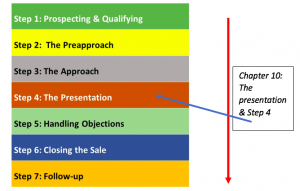10.1. Preparing for a Sales Presentation

You’ve made it! After all your hard work you have reached the point in the selling process where the qualifying, researching, and planning stages pay off. Finally, your story and the customer’s story are
about to connect in an exciting way. Most salespeople think of the presentation as the best part of the selling process. It is the opportunity to show the prospect that you know your stuff—and the chance to deliver value by putting your problem solving skills to work. So get ready, visualize the best possible outcome to your sales presentation, and take the necessary steps to make this outcome a reality. Here are some tips to think about when getting your presentation prepared:
Keep Your Eye on the Prize
As excited as you might be about your product, or as eager as you are to demonstrate your solution, keep in mind that your sales presentation is primarily about building a relationship and beginning a partnership, especially in the business-to-business (B2B) arena. Some research indicates that it can take up to eight meetings to make a sale so breathe, and prepare (Shultz, 2020). Think about what your goal is and what your prospect might want out of the meeting. Review your precall objectives and it can be a good idea to visualize the outcome before going into the meeting. This is not just about calming your nerves; visualizing the outcome you want is actually a powerful tool to help you achieve that outcome. For one thing, it is another form of planning. Each step of the presentation will come naturally to you because you have already mentally rehearsed, and you will be better positioned to sell adaptively because you have already imagined a number of possible scenarios and customer responses.
The Power to Adapt
The sales presentation is where adaptive selling makes all the difference. Up until this point, you have researched and prepared and developed a solution that you think will meet your prospect’s needs, but walking into the presentation and delivering on that preparation requires a different set of skills. Among other things, it requires flexibility and the ability to think on your feet. The best salespeople adapt their presentations to their prospect’s reactions, and they go in knowing they may have to adapt to surprises for which they were unable to prepare (maybe the building has a power outage during the presentation, for instance, or maybe one of the people from the customer organization decides to send another employee in their place at the last minute). These top-performing salespeople know that keeping a customer-centric focus, visualizing a successful outcome, and mentally rehearsing your presentation before you deliver it will give you the power to adapt with confidence and ease.
Logistics Matter
There’s nothing worse than putting hours into preparing a killer sales presentation, only to blow your chances because you forgot to bring an important part of your demonstration or because you got lost on your way to the meeting. Don’t let disorganization hold you back: take charge of the details so that your only concern on the day of the presentation is the delivery. The night before, you should also get together all the materials you’ll need for your presentation— handouts, files, product samples, and contracts—and have them ready to go for the following morning. This will save you time tracking down loose supplies at the last minute, when you’re trying to get out the door to make it to your meeting. If you are planning to use multimedia equipment in your presentation, make sure in advance that your prospect will have everything you’ll need to make it run. If you aren’t sure, bring everything (e.g., cables, adapters, remotes) with you. And of course, make sure you know how to use all your equipment.
Getting There
It might surprise you to know how often salespeople show up late to their own presentations because they get lost on the way to the meeting. When you are traveling to an unfamiliar place for your appointment, get directions in advance, and allow extra travel time in case of traffic delays or wrong turns. Make sure you also research the parking situation beforehand. If your prospect is a large corporation with its own complex, are there reserved employee lots and visitor lots? Will you have to walk a considerable distance from your car to the meeting room? If you’ll be meeting in an urban area, is street parking available, or will you have to find a parking garage? You don’t want to arrive on time only to get delayed because you spent twenty minutes driving around in search of a parking spot. If something unavoidable does come up to set you back, make sure you call ahead to let your customer know you will be arriving late.
Checklist
When you are starting in sales, it can be helpful to have a checklist to go over before each presentation. See Figure 10.1 for an example:
Checklist for presentations.
- Assemble supplies such as documents, brochures, samples, contracts, thumb drives, website url, laptop, cables, client information etc.
- Copies if you are handing out handouts
- What are you wearing? Check that your clothes fit the environment of the prospect (see Chapter 7)
- Logistics—do you know where you are going and how to get there, where to park, how to get into the building?
- Do you have all the contact information needed?
- Rehearse/ practice
- Review your call objectives and visualize success.

